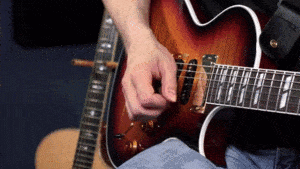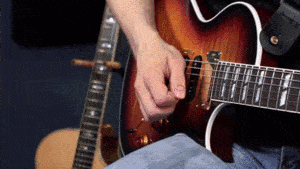The very first technique you’ll want to learn when jumping into the world of lead guitar is picking. In contrast to strumming the guitar, picking the guitar requires a little more dexterity and attention to detail.
When you’re strumming the guitar a lot of the motion comes from your elbow, while picking makes more use of your wrist. Just like strumming, the most important trick to mastering picking the guitar is relaxation. You should be gripping the pick as lightly as possible without having it fall out of your hand. The less tense your picking hand is, the less likely you are to experience any discomfort or injury.
Another important tip is to minimize movement. The smaller the movement, the less distance the pick has to travel to repeat the stroke. This results in increased speed while also minimizing the energy you expend while picking.
We’ll break basic picking technique for lead guitar down into two main parts. These are downstrokes and upstrokes.
Start off by placing the side of your palm on the bridge of the guitar. This will work as your anchor so you don’t get lost by accidentally moving your hand into the wrong position.
Everyone holds their pick a little differently depending on what’s comfortable. The only thing to make sure is that only the tip of your pick is protruding from your fingers. If too much of the pick is sticking out, it can get caught up in the strings or cause you to have to work harder to perform a stroke. Remember, the important thing is to minimize effort and stay relaxed.
Here’s an example of what downstrokes should look like. You can see that the motions are small and controlled.

When performing upstrokes, you’ll employ the same basic techniques as you were for downstrokes. The only difference is the direction you move the pick.
A lot of people struggle with upstrokes as they aren’t as natural of a movement. The key to getting a hang of upstrokes is pick angle. It’s different for everyone but experiment with the angle of your pick so that your upstrokes are as smooth as possible.
It may take you some time to get the hang of upstrokes. Work on just playing upstrokes until it’s committed to muscle memory before moving onto alternate picking.
Look at the image below for an example of upstrokes.

Alternate picking is the combination of downstrokes and upstrokes. This is the primary picking technique that you will use when playing lead guitar.
Alternating between downstrokes and upstrokes literally doubles the speed at which you can pick through notes on the guitar, so spend some time working on mastering this technique.
Always remember to relax and make your motions as small as possible. You can see an example of what alternate picking should look like below.

Are you looking for more lead guitar lessons and relevant jam-tracks? Guitareo is Nate Savage’s step-by-step video training system. It has some great songs for lead guitar and it also covers many other important styles of music including rock, country, fingerstyle, metal, classical, bluegrass, jazz, and more. Best of all it includes a huge library of original jam-tracks so you can apply everything to music.